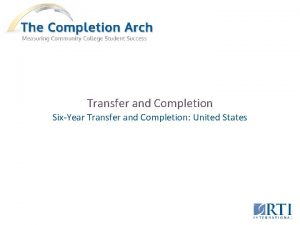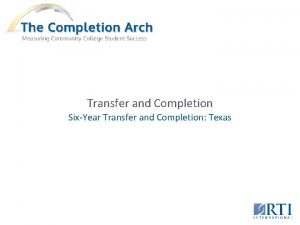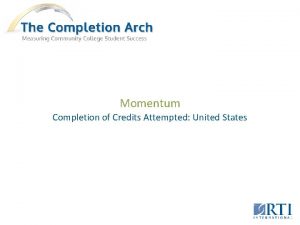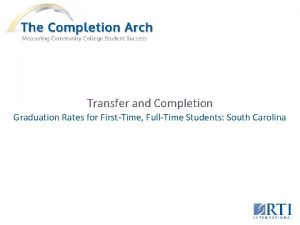Transfer and Completion SixYear Completion Rates United States











- Slides: 11

Transfer and Completion Six-Year Completion Rates: United States

Six-Year Completion Rates: United States What Is Measured? Completion and transfer rates within six years of first enrolling in a community college Who Is Counted? First-time college students who first enrolled in U. S. community colleges in the 2003 -04 academic year as of spring 2009 What It Tells Us Some 46 percent of U. S. community college students attained a credential or transferred to a four-year college within six years: 34 percent of them attained a credential, while an additional 11 percent transferred to a four-year institution but had not yet attained a credential. Among the students who attained a credential (34 percent), 12 percent earned a bachelor's degree, 14 percent earned an associate degree, and 8 percent earned a certificate. Among the students who did not attain a credential (66 percent), 20 percent were still enrolled after six years, and 46 percent left community college with no credential. The rates of completion or transfer were associated with the highest level of education attained by either of the students' parents. Only 8 percent of students whose parents did not attend college earned a bachelor's degree compared with 12 percent of students who had a parent with some college education and 18 percent of students who had a parent with a bachelor's degree. Students whose parents did not attend college were also more likely to have left community college without a credential (51 percent) compared with students who had a parent with some college education (43 percent) or a bachelor's degree (40 percent). Full-time attendance or a mix of full- and part-time attendance was associated with higher combined rates of completion and transfer than exclusive part-time attendance (56 percent and 51 percent, respectively, vs. 16 percent). Why It's Important At community colleges, graduation means attainment of a certificate or associate degree. However, many students attend community colleges to take lower-division courses for a bachelor's degree, and some transfer to a four-year institution without obtaining a credential. From the perspective of the community college, these students have finished a curriculum that prepared them for transfer

Completion and transfer rates for United States Community Colleges, by student and program characteristics

Completion and transfer rates for United States Community Colleges, by student and program characteristics

Completion and transfer rates for United States Community Colleges, by student and program characteristics

Completion and transfer rates for United States Community Colleges, by student and program characteristics

Completion and transfer rates for United States Community Colleges, by student and program characteristics

Completion and transfer rates for United States Community Colleges, by student and program characteristics

Completion and transfer rates for United States Community Colleges, by student and program characteristics

Completion and transfer rates for United States Community Colleges, by student and program characteristics

Data Sources - U. S. Department of Education, National Center for Education Statistics, 2003 -04 Beginning Postsecondary Students Longitudinal Study, Second Follow-up (BPS: 04/09). About the Data - Full-time/part-time enrollment: indicates student's cumulative enrollment through 2009. Full-time is defined as 12 or more credit hours per semester. Race/ethnicity: Other includes Native American, Native Hawaiian or other Pacific Islander, and individuals who indicated Other or Two or more races. Race categories exclude Hispanic/Latino origin unless specified. Social sciences and humanities: includes cultural and gender studies; visual and performing arts; English language and literature; family and consumer sciences; philosophy, theology, and religious studies; psychology; social sciences and history; and liberal arts, general studies, and humanities. STEM: includes agricultural and natural resource studies; biological and biomedical sciences; computer and information sciences and support; engineering; mathematics and statistics; physical sciences; science technologies and technicians; and engineering technologies and related fields. Income percentile rank: calculated separately for dependent and independent students and then combined. Each ranking thus compares the respondent only with other respondents having the same dependency status. Uses parents' income if respondent is dependent and uses respondent's own income if respondent is independent. Some figures do not sum to totals due to rounding.
 A rate is a ratio that compares
A rate is a ratio that compares Equivalent ratios guided notes
Equivalent ratios guided notes Ratios rates and unit rates
Ratios rates and unit rates Ratios rates and unit rates
Ratios rates and unit rates Awake the united states
Awake the united states United states and canada physical map
United states and canada physical map World map with latitude and longitude lines
World map with latitude and longitude lines Mediterranean climate in us
Mediterranean climate in us The physical geography of the united states and canada
The physical geography of the united states and canada Us history regents essay
Us history regents essay Unit 2 the united states and canada worksheet answers
Unit 2 the united states and canada worksheet answers The united states emerges as a world power
The united states emerges as a world power





















